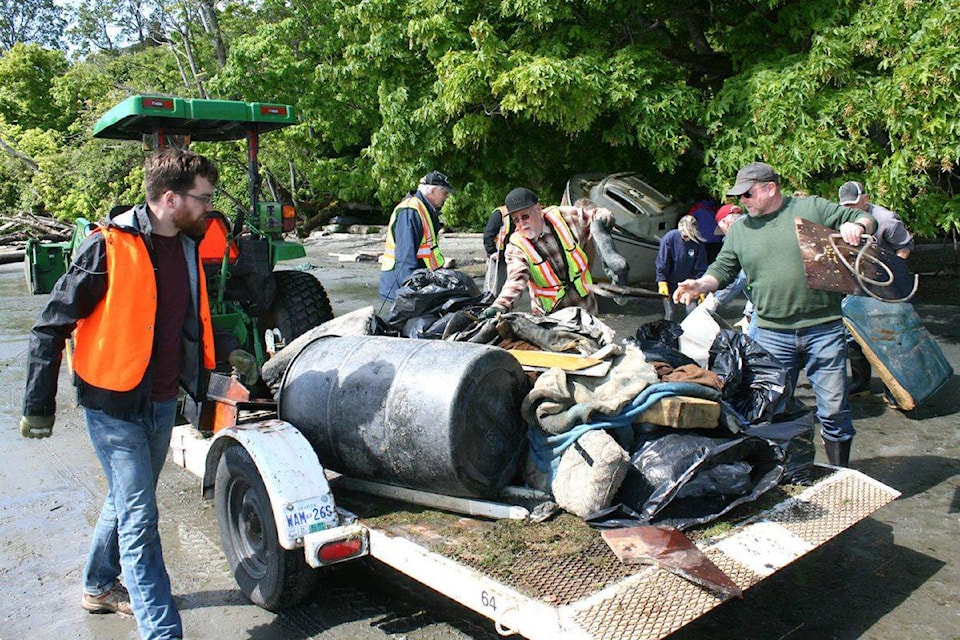A common interest group including the Community Association of Oak Bay, Cadboro Bay Residents Association, Royal Victoria Yacht Club, Veins of Life Watershed Society, Oak Bay, Saanich, C-Tow and Ralmax, plan to apply for newly announced funding to finish cleaning the shores of Cadboro Bay.
The group started the process with a day cleanup in May but fell short in funding.
“I think it’s good news. I’ve already met with some volunteers who are intent on putting together an application for funding. In order to clean up the beach the federal funding will come in very handy for volunteer groups,” said Oak Bay Mayor Nils Jensen. “It will help fill that gap for actual removal and disposal of boats which can become very expensive. The last time the volunteers were down there Oak Bay provided some staff and equipment to help out but the funding provided wasn’t enough.
Earlier this week, Transportation Minister Marc Garneau announced the launch of a national, five-year $6.85 million Abandoned Boats Program led by Transport Canada. It would facilitate removal of existing smaller high-priority abandoned boats, educate boat owners about their responsibilities, and support research into improving recycling options for boats.
“Abandoned boats in Canada can pollute the marine environment, harm local businesses such as tourism and fisheries, damage infrastructure, interfere with navigation, and pose health and safety risks to Canadians. Through the Oceans Protection Plan, our new Abandoned Boats Program will not only remove the highest priority small boats, but also help owners better understand how they can better protect our coasts and waterways,” Garneau said during the announcement.
The Abandoned Boats Program provides grant and contribution funding to assist in the removal of abandoned and/or wrecked small boats posing a hazard in Canadian waters. It features two components Assessment and Removals (A&R), funding boat removal assessments and the permanent removal and disposal of abandoned or wrecked small boats. The Education, Awareness and Research (EA&R) Component funds public education projects aimed at raising awareness about boat owner responsibility, including proper end-of-life management practices. It also funds research on environmentally responsible boat design and recycling of end-of-life boats.
For 2017-18 funding, the A&R application deadline is Oct. 30 and EA&R projects application deadline is Sept. 30.
The group seems to fit into the eligibility criteria, Jensen said. It’s open to provinces, territories, municipalities and local governments; indigenous groups, communities and organizations; private ports or marinas; Canadian port authorities; academia and for-profit and not-for-profit organizations.
The cleanup at Cadboro Bay is co-operative of almost all those groups.
“Then the question is how many people will be applying?” Jensen said. “Saanich and Oak Bay are not particularly unique. This is a problem up and down Vancouver Island. In many small harbour’s there are derelict boats.”
The Abandoned Boats Program provides funding to support the assessment, removal and disposal of existing high-priority abandoned and wrecked boats. The Government of Canada will pay 100 per cent of eligible project costs for boat assessment projects, and up to 75 per cent for boat removal and disposal projects. In exceptional circumstances, a higher cost-sharing amount may be available to recipients for removal and disposal projects.
Assessment and Removal Projects are funded for $5.6 million over five years.
“It’s unfortunate that it’s not more. I think they’re going to run out of money before they run out of boats to take out,” said Gordon Wilkinson, Commodore at Royal Victoria Yacht Club that offered its hoists and ramps to pull vessels from the water for transport. “It’s a common problem in all the harbours on the coast. We do hear about it from other clubs, they’re all dealing with the problem.”
The coalition of community groups plans to offer a joint application for funding.
“This would range from the province right down to the residents’ associations and the yacht club. I think it should get some support,” Wilkinson said.
“We could be in the range from $8,000 to $10,000 land most of that is just for disposal because Ralmax and C-Tow have volunteered to do the heavy work and transportation.”
Cadboro Bay Residents’ Association got the ball rolling after years of vessels piled up in Cadboro Bay. After the District of Saanich cleaned up its side, residents sought to get the Oak Bay side cleared of debris.
“It’s to stop the pollution that comes from them as well as the unsightly mess and the way it affects the foreshore. All the neighbours in that area would like to see them gone,” Wilkinson said.
The federal government also announced, Under the Oceans Protection Plan launched last fall, Fisheries and Oceans Canada is working with the Canadian Coast Guard to prevent and clean up wrecked and abandoned boats and hold owners accountable. A separate program for abandoned and wrecked vessels at Fisheries and Oceans Canada’s commercial fishing harbours will be launched this summer. Over the next five years, $1.3 million of funding will be available to provide support to Harbour Authorities and other eligible recipients in removing and disposing of abandoned and wrecked vessels located in small craft harbours across the country.
